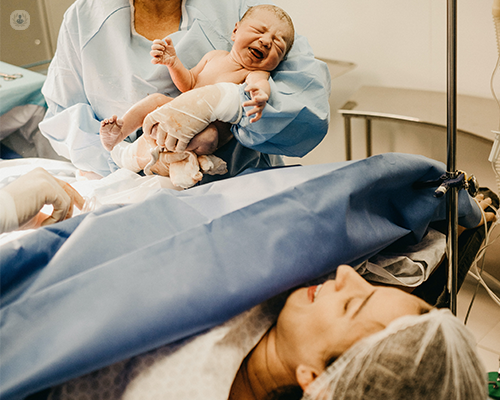What is a caesarean?
A caesarean (also referred to as caesarean section or C-section), is performed to surgically remove an unborn baby born from its mother’s womb via an incision through the mother's abdomen.
In most cases, it is a safe procedure for both the mother and the baby. However, being a surgical procedure, it does involve the possible risks of any surgical intervention.

Why is a caesarean performed?
Caesareans can be planned weeks or days in advance (due to the mother’s birthing preference or to known health risks) or suddenly as an emergency procedure during natural birth. This will be performed by a consultant obstetrician.
There are several reasons for a caesarean:
- The mother has a serious illness such as heart disease, uterine fibroids, HIV, or has previously had a caesarean or uterine surgery.
- The mother has as an active herpes infection.
- The size or position of the baby: the baby’s head or its whole body is too big to fit through the vagina.
- The mother has a multiple pregnancy (more than one child in the womb).
- The baby’s health is deteriorating.
- Labour is progressing too slowly or not at all.
- Problems with the placenta and/or the umbilical cord.
What does a caesarean involve?
The process takes place when the woman is awake but epidural anaesthesia or spinal anaesthesia is used to numb any pain.
The caesarean section technique is as follows:
- The surgeon will make an incision through the abdomen just in the upper part of the pubic area.
- The womb and amniotic pouch are opened.
- The baby is removed through the opening.
- The baby is cleaned and the umbilical cord is cut.
- The area of the incision is sanitised and the incision is closed.
The duration of a caesarean section is usually around one hour.
How do you prepare for a caesarean?
As with any surgery, the patient will undergo a physical examination and a study of their clinical history. However, many caesareans are carried out when unexpected problems prevent safe delivery during natural birth. Unexpected problems that pose a risk to the mother and/or baby mean that caesareans are unexpected and therefore, mothers aren’t always prepared to have the surgery.
Aftercare
After a caesarean, the mother usually stays in the hospital for around three to four days to recover from surgery. Overall, the recovery from a caesarean is longer than recovery from a vaginal delivery.
Immediately after the caesarean section, the patient might feel dizzy and nauseous but these are normal symptoms post-surgery. After surgery, the patient will be transferred to a recovery room where her health will be monitored. It’s recommended that the patient tries to walk at least once a day to assist with recovery.
Alternatives to caesarean
Aside from vaginal delivery and a caesarean, there is the alternative of a water birth. In this case, when the contractions begin, the mother is immersed in a bathtub with warm water. The water fosters a calm environment for the baby to be born.
03-14-2017 09-06-2023Caesarean
Dr Shazia Malik - Obstetrics & gynaecology
Created on: 03-14-2017
Updated on: 09-06-2023
Edited by: Jay Staniland
What is a caesarean?
A caesarean (also referred to as caesarean section or C-section), is performed to surgically remove an unborn baby born from its mother’s womb via an incision through the mother's abdomen.
In most cases, it is a safe procedure for both the mother and the baby. However, being a surgical procedure, it does involve the possible risks of any surgical intervention.

Why is a caesarean performed?
Caesareans can be planned weeks or days in advance (due to the mother’s birthing preference or to known health risks) or suddenly as an emergency procedure during natural birth. This will be performed by a consultant obstetrician.
There are several reasons for a caesarean:
- The mother has a serious illness such as heart disease, uterine fibroids, HIV, or has previously had a caesarean or uterine surgery.
- The mother has as an active herpes infection.
- The size or position of the baby: the baby’s head or its whole body is too big to fit through the vagina.
- The mother has a multiple pregnancy (more than one child in the womb).
- The baby’s health is deteriorating.
- Labour is progressing too slowly or not at all.
- Problems with the placenta and/or the umbilical cord.
What does a caesarean involve?
The process takes place when the woman is awake but epidural anaesthesia or spinal anaesthesia is used to numb any pain.
The caesarean section technique is as follows:
- The surgeon will make an incision through the abdomen just in the upper part of the pubic area.
- The womb and amniotic pouch are opened.
- The baby is removed through the opening.
- The baby is cleaned and the umbilical cord is cut.
- The area of the incision is sanitised and the incision is closed.
The duration of a caesarean section is usually around one hour.
How do you prepare for a caesarean?
As with any surgery, the patient will undergo a physical examination and a study of their clinical history. However, many caesareans are carried out when unexpected problems prevent safe delivery during natural birth. Unexpected problems that pose a risk to the mother and/or baby mean that caesareans are unexpected and therefore, mothers aren’t always prepared to have the surgery.
Aftercare
After a caesarean, the mother usually stays in the hospital for around three to four days to recover from surgery. Overall, the recovery from a caesarean is longer than recovery from a vaginal delivery.
Immediately after the caesarean section, the patient might feel dizzy and nauseous but these are normal symptoms post-surgery. After surgery, the patient will be transferred to a recovery room where her health will be monitored. It’s recommended that the patient tries to walk at least once a day to assist with recovery.
Alternatives to caesarean
Aside from vaginal delivery and a caesarean, there is the alternative of a water birth. In this case, when the contractions begin, the mother is immersed in a bathtub with warm water. The water fosters a calm environment for the baby to be born.


Emergency caesareans: how painful and safe are they? FAQs answered by a specialist
By Mr Christian Barnick
2025-02-06
There are categories of emergency caesarean section (C-section). Mr Christian Barnick regularly performs caesareans (both emergency and non-emergency) and he provides you with insight into when emergency caesareans are necessary and what to expect regarding pain and safety, should you need one. See more


C-section: is it the right choice for me?
By Ms Laura Fulwell-Smith
2025-02-02
Highly regarded consultant obstetrician Ms Laura Fulwell-Smith explains why expectant mothers may undergo a caesarean (C-section), risks and potential long-term health implications linked to the procedure. See more


Childbirth: What type of delivery is right for me?
By Dr Srividhya Sankaran
2025-01-30
Leading consultant in maternal-fetal medicine and obstetrics Dr Srividhya Sankaran offers expert advice for women planning for childbirth on the various approaches used to deliver babies in this informative article. See more


How to plan for a C-section
By Dr Shazia Malik
2025-01-30
Distinguished consultant obstetrician and gynaecologist Dr Shazia Malik discusses what to consider before a C-section, and what to discuss with your gynaecologist before making a decision about the procedure. See more
Experts in Caesarean
-
Dr Shazia Malik
Obstetrics & gynaecologyExpert in:
- Menopause
- Caesarean
- Miscarriage
- Pregnancy counselling
- Polycystic ovary syndrome (PCOS)
- Heavy periods
-
Dr Vasso Terzidou
Obstetrics & gynaecologyExpert in:
- Premature birth
- Natural childbirth
- High-risk pregnancy
- Cervical cerclage
- Caesarean
- Antenatal care
-
Mr Keith Duncan
Obstetrics & gynaecologyExpert in:
- Breakthrough bleeding
- Caesarean
- Childbirth
- Multiple pregnancy
- Ultrasound
- High-risk pregnancy
-
Mr Christian Barnick
Obstetrics & gynaecologyExpert in:
- Endometriosis
- Fibroids
- Hysteroscopy
- Laparoscopy
- Antenatal care
- Caesarean
-
Mr Ian Chilcott
Obstetrics & gynaecologyExpert in:
- Caesarean
- High-risk pregnancy
- Natural childbirth
- Hysterectomy
- Minimal access surgery (keyhole surgery)
- Vaginal prolapse
- See all

Dr Duncan Birth - Mr Keith Duncan
Dr Duncan Birth - Mr Keith Duncan
212 Great Portland Street, London. W1W 5AH
No existe teléfono en el centro.
By using the telephone number provided by TOP DOCTORS, you automatically agree to let us use your phone number for statistical and commercial purposes. For further information, read our Privacy Policy
Top Doctors

The Clementine Churchill Hospital - part of Circle Health Group
The Clementine Churchill Hospital - part of Circle Health Group
Sudbury Hill, Harrow HA1 3RX
No existe teléfono en el centro.
By using the telephone number provided by TOP DOCTORS, you automatically agree to let us use your phone number for statistical and commercial purposes. For further information, read our Privacy Policy
Top Doctors

ObGyn Matters London
ObGyn Matters London
The Portland Hospital, 212 Great Portland Street, W1W 5QN
No existe teléfono en el centro.
By using the telephone number provided by TOP DOCTORS, you automatically agree to let us use your phone number for statistical and commercial purposes. For further information, read our Privacy Policy
Top Doctors
-
Dr Duncan Birth - Mr Keith Duncan
212 Great Portland Street, London. W1W 5AH, Central LondonExpert in:
- Ultrasound
- Pregnancy
- Multiple pregnancy
-
The Clementine Churchill Hospital - part of Circle Health Group
Sudbury Hill, Harrow HA1 3RX, West LondonExpert in:
- Abdominal ultrasound
- Abdominoplasty
- Acne
- Allergies bronchopulmonary
- Allergies nose and ears
- Allergy Dermatitis
-
ObGyn Matters London
The Portland Hospital, 212 Great Portland Street, W1W 5QN, Central LondonExpert in:
- Maternity care
- Diagnostic Imaging
- Endometriosis
- Fibroids
- Obstetrics and Gynaecology
- Women’s health
- See all
- Most viewed diseases, medical tests, and treatments
- Polycystic ovary syndrome (PCOS)
- Osteoporosis
- Menopause support
- Tubal factor infertility
- Complex endometriosis
- Fertility preservation
- Female infertility
- Ovulatory disorders
- Surrogacy
- Pelvic ultrasound







